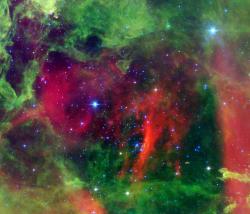 If you’re a newly forming star system, there’s no better place to be than a stellar nursery. All those raw elements make the perfect building blocks of stars and planets. The problem is that super hot giant stars can release great torrents of radiation, blasting away newly forming planets.
If you’re a newly forming star system, there’s no better place to be than a stellar nursery. All those raw elements make the perfect building blocks of stars and planets. The problem is that super hot giant stars can release great torrents of radiation, blasting away newly forming planets.
In a new study gathered using NASA’s Spitzer Space Telescope, astronomers have started to map out these danger zones around the super hot stars. If you’re a cooler star with newly forming planets, you need to be at least 1.6 light-years away. Since the stars are moving around in a stellar nebula, a newly forming system needs to keep this distance at all times. If it strays into one of these danger zones, its new planets will literally be boiled away into interstellar space.
These massive stars are known as type O-stars. They live fast and die young, reaching a mass dozens of time greater than our Sun, and only lasting for a few million years at the most. But during that short life, they can cause quite a lot damage. Astronomers used Spitzer to measure the number of stars with planet forming disks. As the stars got closer to the O-stars, the percentage that had disks dropped dramatically.
Astronomers think that our Sun started out in a similarly dangerous environment, but was able to successfully navigate through the minefield of O-stars until it could reach its current, more spacious home.
Spitzer News Release
